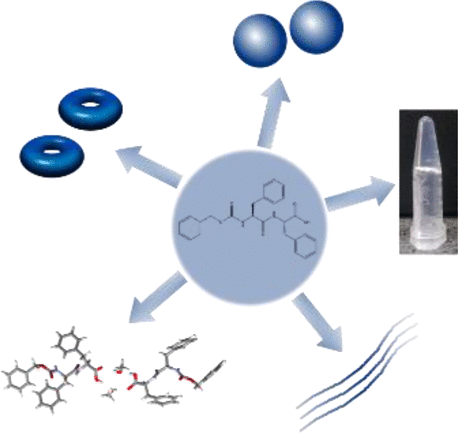Our official English website, www.x-mol.net, welcomes your
feedback! (Note: you will need to create a separate account there.)
Structural Polymorphism in a Self-Assembled Tri-Aromatic Peptide System
ACS Nano ( IF 15.8 ) Pub Date : 2018-03-20 00:00:00 , DOI: 10.1021/acsnano.7b07723 Noam Brown 1, 2 , Jiangtao Lei 3 , Chendi Zhan 3 , Linda J W Shimon 4 , Lihi Adler-Abramovich 5 , Guanghong Wei 3 , Ehud Gazit 1
ACS Nano ( IF 15.8 ) Pub Date : 2018-03-20 00:00:00 , DOI: 10.1021/acsnano.7b07723 Noam Brown 1, 2 , Jiangtao Lei 3 , Chendi Zhan 3 , Linda J W Shimon 4 , Lihi Adler-Abramovich 5 , Guanghong Wei 3 , Ehud Gazit 1
Affiliation

|
Self-assembly is a process of key importance in natural systems and in nanotechnology. Peptides are attractive building blocks due to their relative facile synthesis, biocompatibility, and other unique properties. Diphenylalanine (FF) and its derivatives are known to form nanostructures of various architectures and interesting and varied characteristics. The larger triphenylalanine peptide (FFF) was found to self-assemble as efficiently as FF, forming related but distinct architectures of plate-like and spherical nanostructures. Here, to understand the effect of triaromatic systems on the self-assembly process, we examined carboxybenzyl-protected diphenylalanine (z-FF) as a minimal model for such an arrangement. We explored different self-assembly conditions by changing solvent compositions and peptide concentrations, generating a phase diagram for the assemblies. We discovered that z-FF can form a variety of structures, including nanowires, fibers, nanospheres, and nanotoroids, the latter were previously observed only in considerably larger or co-assembly systems. Secondary structure analysis revealed that all assemblies possessed a β-sheet conformation. Additionally, in solvent combinations with high water ratios, z-FF formed rigid and self-healing hydrogels. X-ray crystallography revealed a “wishbone” structure, in which z-FF dimers are linked by hydrogen bonds mediated by methanol molecules, with a 2-fold screw symmetry along the c-axis. All-atom molecular dynamics (MD) simulations revealed conformations similar to the crystal structure. Coarse-grained MD simulated the assembly of the peptide into either fibers or spheres in different solvent systems, consistent with the experimental results. This work thus expands the building block library for the fabrication of nanostructures by peptide self-assembly.
中文翻译:

自组装三芳香肽系统中的结构多态性
自组装是自然系统和纳米技术中至关重要的过程。肽因其相对容易的合成、生物相容性和其他独特的特性而成为有吸引力的构件。众所周知,二苯丙氨酸 (FF) 及其衍生物可形成具有各种结构和有趣且多样特性的纳米结构。发现较大的三苯丙氨酸肽 (FFF) 与 FF 一样有效地自组装,形成相关但不同的板状和球形纳米结构结构。在这里,为了了解三芳烃系统对自组装过程的影响,我们检查了羧基苄基保护的二苯丙氨酸 (z-FF) 作为这种排列的最小模型。我们通过改变溶剂成分和肽浓度探索了不同的自组装条件,生成组件的相图。我们发现 z-FF 可以形成多种结构,包括纳米线、纤维、纳米球和纳米环形,后者以前仅在相当大的或共组装系统中观察到。二级结构分析显示所有组件都具有β-折叠构象。此外,在具有高水比的溶剂组合中,z-FF 形成了刚性和自修复的水凝胶。X 射线晶体学揭示了一种“叉骨”结构,其中 z-FF 二聚体通过甲醇分子介导的氢键连接,沿 2 倍螺旋对称 二级结构分析显示所有组件都具有β-折叠构象。此外,在具有高水比的溶剂组合中,z-FF 形成了刚性和自修复的水凝胶。X 射线晶体学揭示了一种“叉骨”结构,其中 z-FF 二聚体通过甲醇分子介导的氢键连接,沿 2 倍螺旋对称 二级结构分析显示所有组件都具有β-折叠构象。此外,在具有高水比的溶剂组合中,z-FF 形成了刚性和自修复的水凝胶。X 射线晶体学揭示了一种“叉骨”结构,其中 z-FF 二聚体通过甲醇分子介导的氢键连接,沿 2 倍螺旋对称c轴。全原子分子动力学(MD)模拟揭示了与晶体结构相似的构象。粗粒度 MD 模拟肽在不同溶剂系统中组装成纤维或球体,与实验结果一致。因此,这项工作扩展了通过肽自组装制造纳米结构的构建模块库。
更新日期:2018-03-20
中文翻译:

自组装三芳香肽系统中的结构多态性
自组装是自然系统和纳米技术中至关重要的过程。肽因其相对容易的合成、生物相容性和其他独特的特性而成为有吸引力的构件。众所周知,二苯丙氨酸 (FF) 及其衍生物可形成具有各种结构和有趣且多样特性的纳米结构。发现较大的三苯丙氨酸肽 (FFF) 与 FF 一样有效地自组装,形成相关但不同的板状和球形纳米结构结构。在这里,为了了解三芳烃系统对自组装过程的影响,我们检查了羧基苄基保护的二苯丙氨酸 (z-FF) 作为这种排列的最小模型。我们通过改变溶剂成分和肽浓度探索了不同的自组装条件,生成组件的相图。我们发现 z-FF 可以形成多种结构,包括纳米线、纤维、纳米球和纳米环形,后者以前仅在相当大的或共组装系统中观察到。二级结构分析显示所有组件都具有β-折叠构象。此外,在具有高水比的溶剂组合中,z-FF 形成了刚性和自修复的水凝胶。X 射线晶体学揭示了一种“叉骨”结构,其中 z-FF 二聚体通过甲醇分子介导的氢键连接,沿 2 倍螺旋对称 二级结构分析显示所有组件都具有β-折叠构象。此外,在具有高水比的溶剂组合中,z-FF 形成了刚性和自修复的水凝胶。X 射线晶体学揭示了一种“叉骨”结构,其中 z-FF 二聚体通过甲醇分子介导的氢键连接,沿 2 倍螺旋对称 二级结构分析显示所有组件都具有β-折叠构象。此外,在具有高水比的溶剂组合中,z-FF 形成了刚性和自修复的水凝胶。X 射线晶体学揭示了一种“叉骨”结构,其中 z-FF 二聚体通过甲醇分子介导的氢键连接,沿 2 倍螺旋对称c轴。全原子分子动力学(MD)模拟揭示了与晶体结构相似的构象。粗粒度 MD 模拟肽在不同溶剂系统中组装成纤维或球体,与实验结果一致。因此,这项工作扩展了通过肽自组装制造纳米结构的构建模块库。











































 京公网安备 11010802027423号
京公网安备 11010802027423号